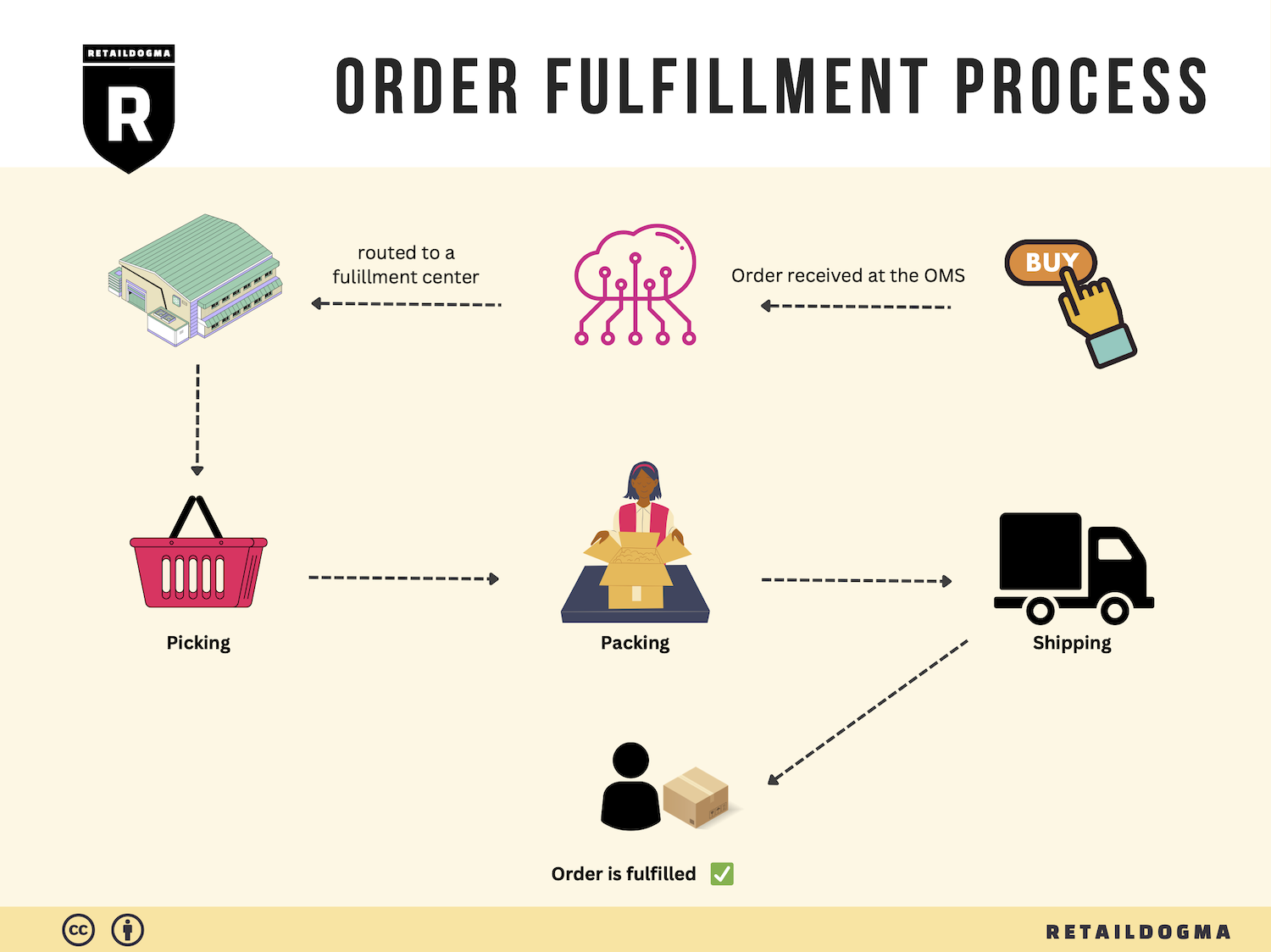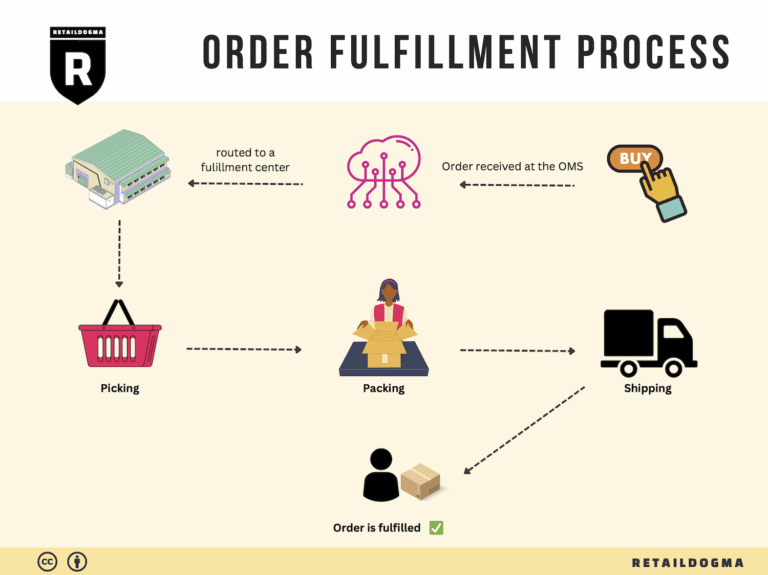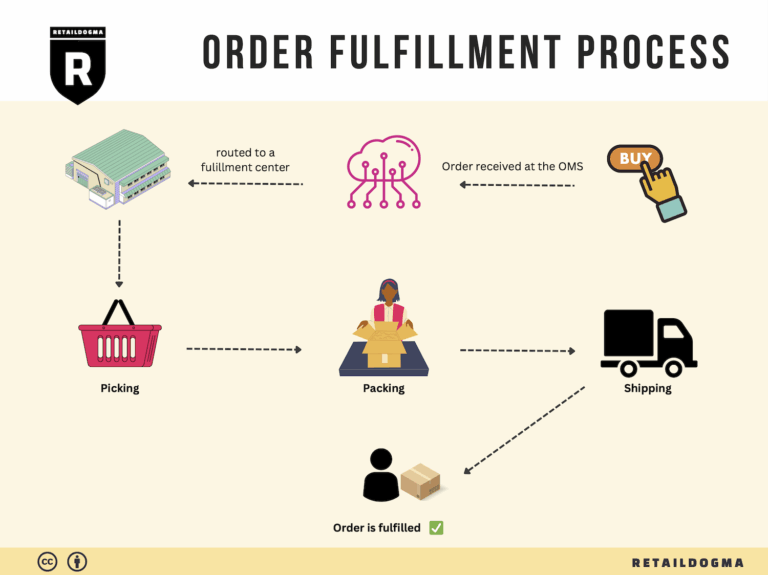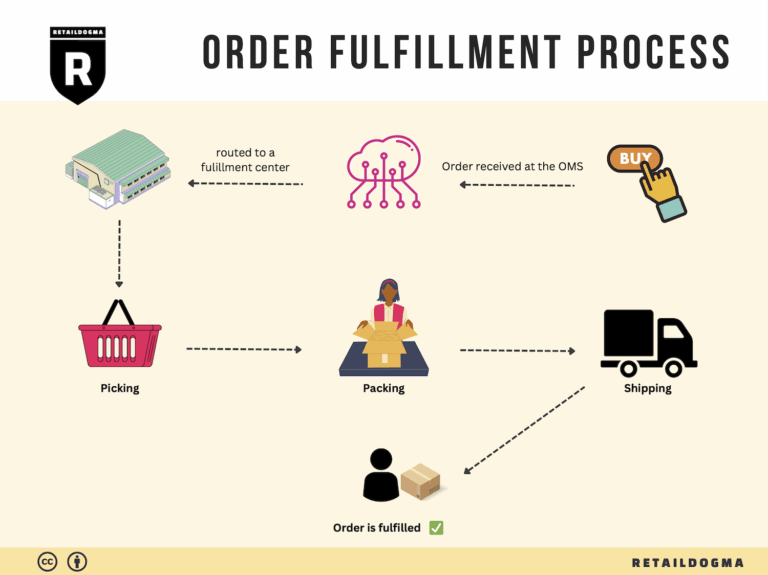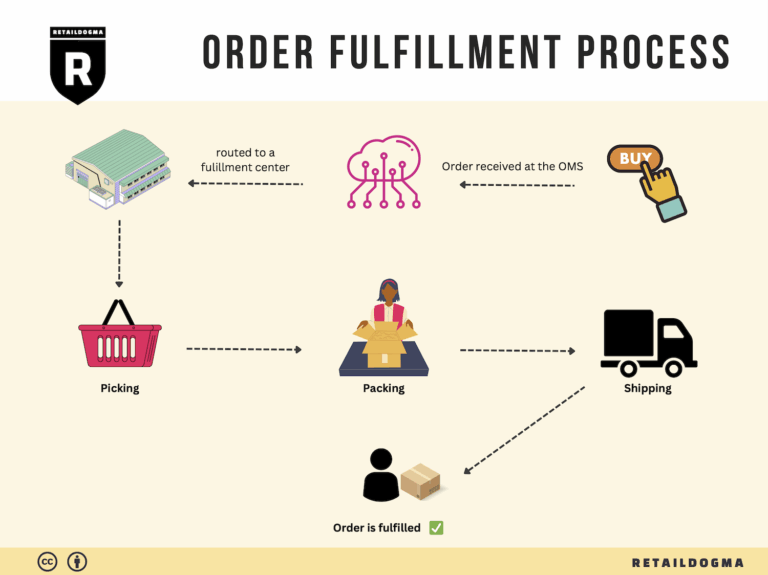Ecommerce Fulfillment Services: The Ultimate Guide (2025)
What is E-commerce Fulfillment? An Introduction for Growing Businesses
As an e-commerce business owner, you may find yourself grappling with a common yet daunting challenge: the overwhelming task of packing and shipping orders. What starts as an exciting journey into online sales can quickly turn into a logistical nightmare as your order volume increases. Managing inventory, packing orders efficiently, and ensuring timely delivery can consume valuable resources and distract you from focusing on growth and customer engagement.
Understanding E-commerce Fulfillment
E-commerce fulfillment is simply the process of getting a product from your warehouse (or supplier) to your customer’s doorstep. This process encompasses several key components, including inventory management, order processing, packaging, shipping, and returns management. For growing businesses, mastering fulfillment is crucial; it directly impacts customer satisfaction and retention, which are essential for scaling your operations.
In this guide, we will explore various fulfillment models that can support your business as it scales. These include Third-Party Logistics (3PL) and Fulfillment by Amazon (FBA), both of which offer distinct advantages depending on your specific needs and resources. Understanding these models will help you select the right approach for your business.
Core Services of E-commerce Fulfillment
We will delve into the core services provided by fulfillment partners, such as inventory storage, order processing, packaging, shipping, and returns management. Each of these services plays a critical role in ensuring that your customers receive their products quickly and in perfect condition.
Choosing the Right Fulfillment Partner
Selecting the right fulfillment partner is a pivotal decision for any growing e-commerce business. This guide will provide insights on what to consider when choosing a fulfillment partner, including their technology, capabilities, customer service, and scalability options.
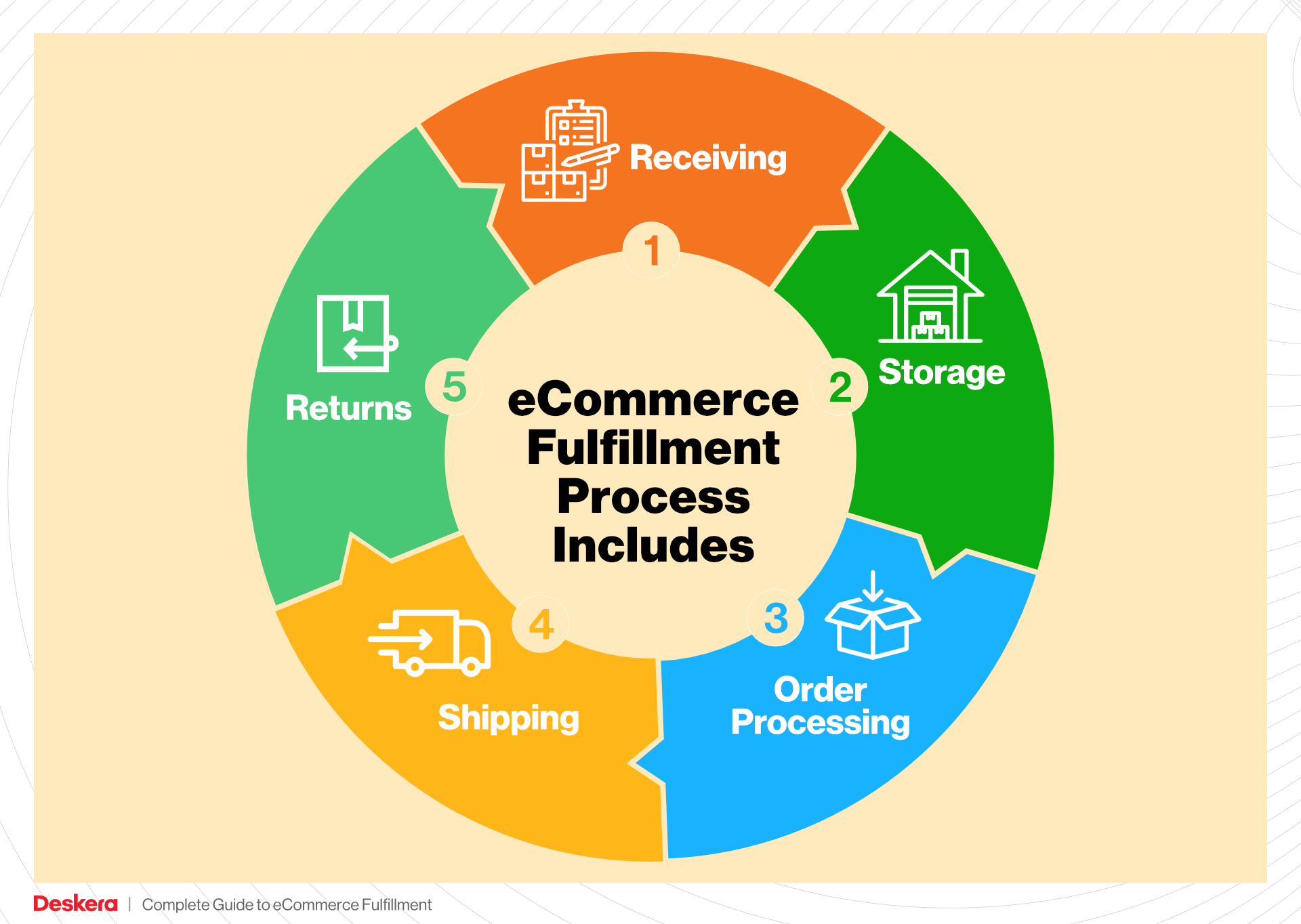
Pricing Considerations
Finally, we will examine the pricing structures typically associated with different fulfillment options. Understanding the cost implications is vital for maintaining profitability while meeting customer expectations.
Empowering Your Business Decisions
The goal of this guide is to empower you to make informed decisions about your logistics strategy. By understanding the intricacies of e-commerce fulfillment, you can streamline your operations, enhance customer satisfaction, and ultimately drive your business growth. Whether you are just starting out or looking to optimize your existing processes, this guide will serve as a valuable resource on your journey to fulfillment excellence.
What You’ll Learn In This Guide
- What is E-commerce Fulfillment? An Introduction for Growing Businesses
- The Order Fulfillment Process: From ‘Buy’ Button to Customer’s Door
- Comparing Fulfillment Models: In-House vs. 3PL vs. Dropshipping
- A Deep Dive into Amazon FBA: Pros, Cons, and Who It’s For
- Core Services Offered by Fulfillment Centers
- How to Choose a Fulfillment Partner: A 6-Point Checklist
- Understanding Fulfillment Pricing: A Breakdown of Common Fees
- Frequently Asked Questions (FAQs) about Fulfillment
- Conclusion: Is Outsourcing Fulfillment the Right Move for Your Business?
- Important Disclaimer
The Order Fulfillment Process: From ‘Buy’ Button to Customer’s Door
1. Receiving Inventory
The first step in the order fulfillment process is receiving inventory. When products arrive at the fulfillment center, they undergo a thorough inspection to ensure quality and accuracy. This is where Stock Keeping Units (SKUs) come into play. Each product is assigned a unique SKU, which helps track inventory levels and manage stock efficiently.
During this phase, staff check the shipments against purchase orders to confirm that the correct items and quantities have been delivered. Any discrepancies, such as damaged goods or missing items, are documented for resolution. This step is critical because it sets the foundation for effective inventory management. Proper receiving ensures that the inventory is accurate and up-to-date, minimizing the risk of stockouts or overstock situations that can hinder sales and operational efficiency.
2. Warehouse Storage
Once the inventory is received and verified, it is then moved to designated storage areas within the warehouse. Efficient warehouse storage is vital for optimizing space and ensuring quick access to products. This involves categorizing and shelving items according to their SKUs, which allows for easy identification and retrieval.
This step is important because organized storage directly impacts the speed and accuracy of order picking later in the fulfillment process. By implementing systems such as bin locations or zone picking, businesses can streamline their storage strategy. This not only maximizes available space but also enhances the overall workflow, allowing for faster order processing and improved customer satisfaction.
3. Order Picking
When a customer places an order, the next step is order picking. This process involves selecting the items from the warehouse that correspond to the order. Staff use pick lists, which are generated based on the orders received. These lists detail the SKUs and quantities needed, guiding workers through the warehouse efficiently.
Order picking is a critical step because it directly affects order accuracy and fulfillment speed. If items are picked incorrectly, it can lead to delays, returns, and dissatisfied customers. To enhance the picking process, many fulfillment centers adopt various picking methods, such as single order picking, batch picking, or wave picking, depending on their order volume and operational capacity. By optimizing this stage, businesses can ensure they meet customer expectations for timely and accurate deliveries.
4. Order Packing
Once the items are picked, they move to the packing stage. This step involves securely packaging the products for shipment. Proper packing is essential for preventing damage during transit and ensuring that items arrive at the customer’s door in perfect condition. Key terms associated with this process include packing slips and shipping labels.
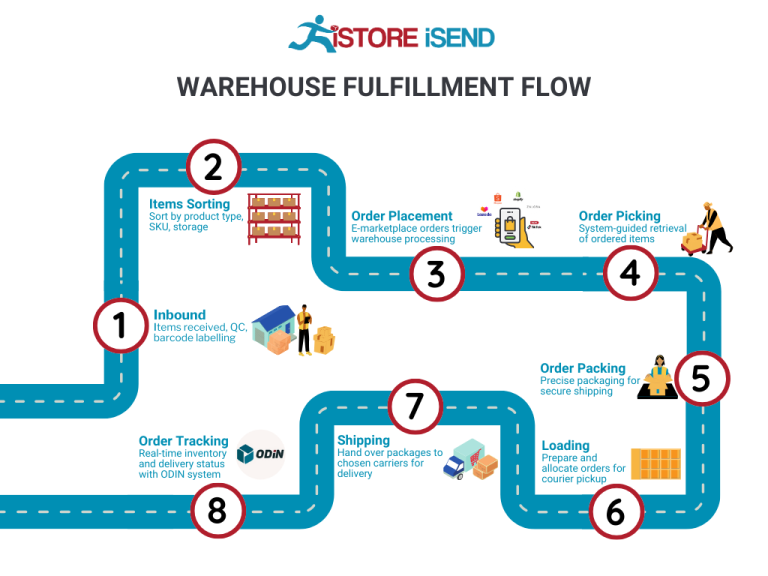
Packing slips accompany the order and provide customers with a summary of the items included, while shipping labels contain vital information for carriers. Effective packing also involves selecting the appropriate box size and materials to minimize shipping costs and reduce environmental impact. This step is important as it not only protects the product but also reflects the brand’s commitment to quality and customer service.
5. Shipping & Delivery
The final step in the order fulfillment process is shipping and delivery. Once orders are packed, they are handed over to shipping carriers for delivery to the customer’s address. Businesses must choose reliable shipping partners and determine the best shipping methods based on cost, speed, and customer preferences. Key considerations in this step include tracking numbers and delivery timeframes.
Effective shipping and delivery are crucial for maintaining customer satisfaction and loyalty. Providing customers with tracking information allows them to monitor their order’s progress, reducing anxiety and enhancing the shopping experience. Additionally, timely delivery aligns with the expectations set during the purchase process, which is essential for building trust and encouraging repeat business.
In summary, understanding and optimizing each step of the order fulfillment process—from receiving inventory to shipping and delivery—enables e-commerce businesses to scale efficiently and enhance customer satisfaction. By focusing on these key areas, businesses can streamline operations, reduce costs, and ultimately drive sales growth.
Comparing Fulfillment Models: In-House vs. 3PL vs. Dropshipping
Comparison of Fulfillment Models
| Model | Who Handles Inventory | Best For (Business Stage) | Key Advantage | Key Disadvantage |
|---|---|---|---|---|
| In-House Fulfillment | Business | Startups, Established Brands | Full control over inventory and processes | High upfront costs and operational complexity |
| Third-Party Logistics (3PL) | Third-party provider | Growing Brands, Mid-sized Businesses | Scalability and reduced operational burden | Less control over inventory and potential for miscommunication |
| Dropshipping | Supplier | Startups, New Entrepreneurs | Low startup costs and no inventory risk | Lower profit margins and dependency on suppliers |
In-House Fulfillment
In-house fulfillment involves managing the entire supply chain process within the business. This model allows e-commerce companies to control all aspects of inventory management, from storage to order processing and shipping. Businesses that adopt this model typically invest in warehousing space, technology, and staff to handle logistics operations. It is best suited for startups and established brands that require flexibility and want to maintain a high level of quality control over their products and services. The key advantage of in-house fulfillment is the ability to customize processes and respond quickly to changes in demand or customer preferences. However, this model can also lead to high upfront costs related to infrastructure and labor, as well as operational complexity, which can divert focus from core business activities.
Third-Party Logistics (3PL)
Third-party logistics (3PL) providers are external companies that manage logistics functions on behalf of businesses. This model is ideal for growing brands and mid-sized businesses that need to scale their operations without the burden of managing logistics internally. By outsourcing warehousing, inventory management, and shipping to a 3PL, businesses can focus on their core competencies like marketing and product development. The key advantage of using a 3PL is scalability; businesses can easily adjust their logistics operations based on sales fluctuations without significant investment in infrastructure. However, this model does come with its challenges, including less control over inventory and potential miscommunication between the business and the logistics provider, which can lead to delays or errors in order fulfillment.
Dropshipping
Dropshipping is a fulfillment model where the retailer does not hold inventory but instead transfers customer orders directly to a supplier, who then ships the products to the customer. This model is particularly attractive for startups and new entrepreneurs because it requires minimal upfront investment and eliminates inventory risk. The key advantage of dropshipping is the ability to offer a wide range of products without the need to invest in inventory or warehousing. However, dropshipping also has notable disadvantages, such as lower profit margins due to reliance on suppliers and a lack of control over product quality and shipping times. Retailers must carefully vet their suppliers to ensure reliability and quality, as any issues on the supplier’s end can directly impact customer satisfaction and the retailer’s brand reputation.
A Deep Dive into Amazon FBA: Pros, Cons, and Who It’s For
Understanding Fulfillment by Amazon (FBA)
Fulfillment by Amazon (FBA) is a service offered by Amazon that allows sellers to store their products in Amazon’s fulfillment centers. Amazon then takes care of storage, packaging, shipping, and customer service for these products. This service is particularly beneficial for e-commerce businesses looking to scale operations without the overhead of managing their own logistics.
When a customer orders a product, Amazon handles the entire fulfillment process, from picking and packing the item to shipping it directly to the customer. This not only streamlines operations for sellers but also enhances the customer experience by leveraging Amazon’s extensive logistics network and expertise.
How FBA Works
-
Setting Up Your FBA Account: Sellers must first create an Amazon Seller account and register for FBA. This includes providing essential business information and agreeing to FBA’s terms and conditions.
-
Listing Products: Once registered, sellers can list products for sale on Amazon. They can choose to have their products fulfilled by Amazon by selecting the FBA option.
-
Shipping Inventory: Sellers send their products to Amazon’s fulfillment centers. This can be done in bulk, and Amazon provides specific guidelines on how to prepare and package items for shipment.
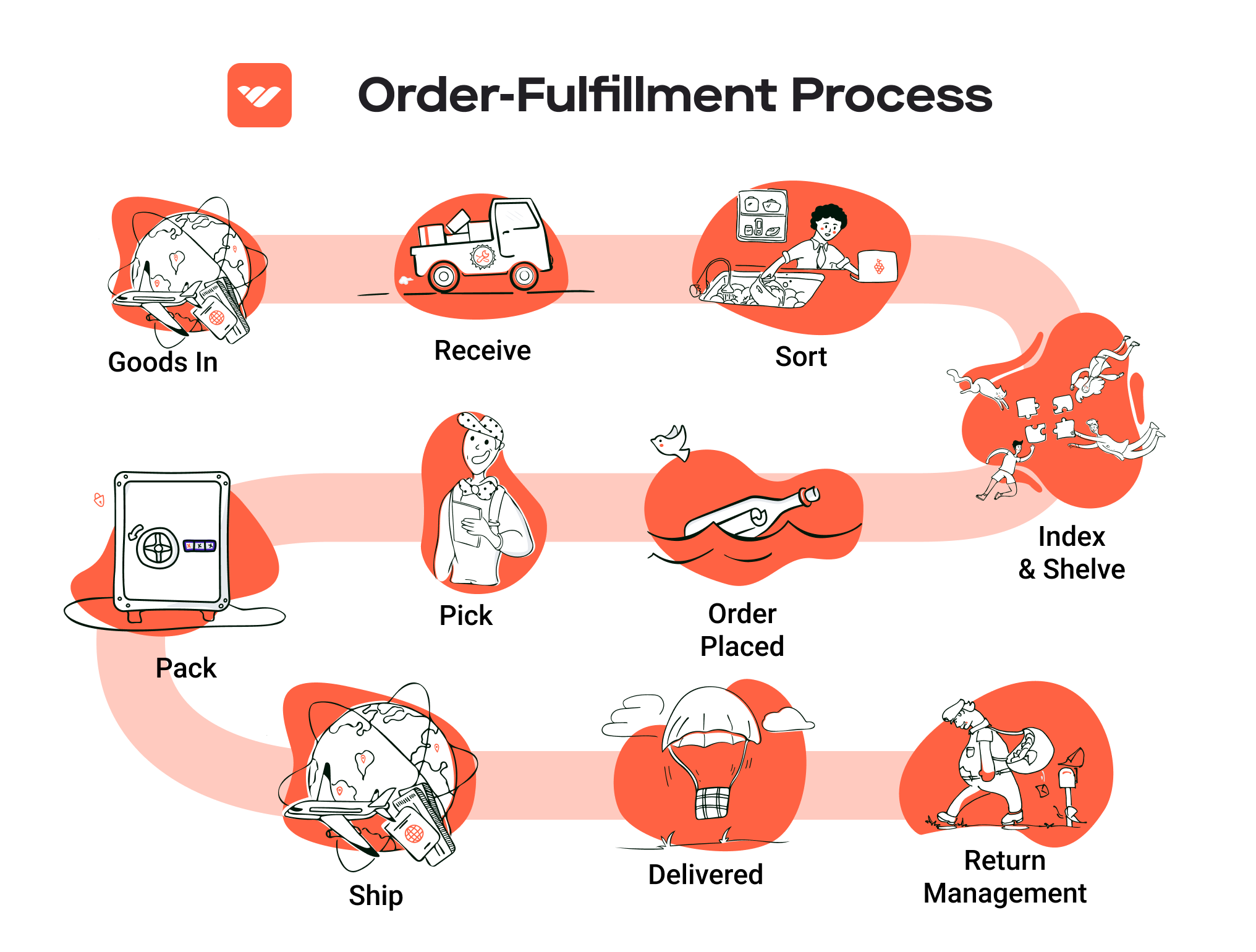
-
Amazon Takes Over: After the products are received at the fulfillment center, Amazon takes care of storage, order processing, packing, and shipping.
-
Customer Orders: When a customer places an order, Amazon picks the item from the warehouse, packs it, and ships it directly to the customer.
-
Customer Service and Returns: Amazon also handles customer inquiries and returns, providing a seamless experience for both sellers and buyers.
Pros of Using FBA
Prime Eligibility
One of the most significant advantages of FBA is that products fulfilled by Amazon are automatically eligible for Amazon Prime. This means that Prime members can benefit from free two-day shipping on eligible items, which can significantly enhance sales potential and customer satisfaction.
Customer Trust
Amazon is synonymous with reliability and customer service. By using FBA, sellers can leverage Amazon’s trusted brand, which can lead to increased sales. Customers are more likely to purchase from sellers who use FBA due to the assurance of fast shipping and easy returns.
Multi-Channel Fulfillment
FBA allows sellers to fulfill orders from various sales channels, not just Amazon. Whether a seller sells through their own website or other platforms, they can utilize Amazon’s fulfillment services to handle logistics, simplifying operations and ensuring consistency in shipping times.
Cons of Using FBA
High Fees
FBA is not without its costs. Sellers must pay various fees, including storage fees for inventory stored in Amazon’s warehouses and fulfillment fees for each item sold. These fees can add up, especially for low-margin products, potentially squeezing profits.
Strict Inventory Rules
Amazon has stringent inventory management policies. Sellers must adhere to guidelines regarding inventory limits, preparation requirements, and labeling. Failure to comply can result in additional charges or even suspension of FBA privileges.
Commingling Risks
FBA uses a commingling process where products from different sellers are stored together. This can lead to issues if a seller’s products are mixed with counterfeit or damaged items, potentially harming their reputation and customer trust. Sellers must be cautious and consider whether to use the labeling option to mitigate these risks.
Who is FBA Best For?
FBA is an ideal solution for various types of sellers, particularly those looking to scale their e-commerce business. Here’s a closer look at who may benefit the most from FBA:
-
Small to Medium-Sized Businesses: Companies that lack the resources or infrastructure to manage logistics effectively can leverage FBA to access Amazon’s vast fulfillment network without significant investment in warehousing and shipping.
-
High-Volume Sellers: Businesses that sell a large volume of products can benefit from FBA’s efficient handling of logistics, allowing them to focus on growing their brand and product offerings.
-
Brands Seeking to Enhance Visibility: Companies looking to boost their product visibility on Amazon can take advantage of Prime eligibility and Amazon’s trusted reputation, which can lead to higher conversion rates.
-
Multi-Channel Sellers: Sellers who operate across multiple platforms and want to streamline their fulfillment process can benefit from FBA’s multi-channel fulfillment capabilities.
In conclusion, while FBA offers a robust solution for e-commerce businesses aiming to scale their operations, it’s essential to weigh the advantages against the potential drawbacks. For many sellers, the benefits of increased visibility, customer trust, and logistical support can outweigh the costs and challenges associated with using Amazon’s fulfillment services.
Core Services Offered by Fulfillment Centers
Inventory Management & Warehousing
Inventory management and warehousing are foundational services provided by fulfillment centers. These services involve the systematic tracking and storage of products, ensuring that businesses have the right amount of stock on hand to meet customer demand without overstocking. Fulfillment centers utilize sophisticated inventory management software that provides real-time visibility into stock levels, order processing, and sales trends.
The benefits of effective inventory management include reduced holding costs, improved cash flow, and increased operational efficiency. By outsourcing inventory management to a fulfillment center, e-commerce businesses can focus on core activities such as marketing and product development. Furthermore, advanced warehousing solutions can optimize storage space and streamline picking processes, allowing for quicker order fulfillment and enhanced customer satisfaction.
Pick and Pack Services
Pick and pack services are crucial in the order fulfillment process. This service involves selecting the right products from the warehouse (picking) and packaging them for shipment (packing). Fulfillment centers employ trained staff and automated systems to ensure accuracy and efficiency in this process. Each order is carefully picked according to the specifications provided by the customer and then packed in a manner that minimizes the risk of damage during transit.
The primary benefit of pick and pack services is the speed and accuracy they bring to order fulfillment. With a dedicated team handling these tasks, e-commerce businesses can significantly reduce order processing times, leading to faster shipping and improved customer experiences. Additionally, fulfillment centers often use standardized packing materials, which can reduce shipping costs and enhance brand presentation.
Kitting and Assembly
Kitting and assembly services involve the grouping of multiple products into a single package or the assembly of products before shipping. This service is particularly beneficial for businesses that offer bundled products or require assembly before delivery, such as furniture or electronic items. Fulfillment centers can assemble products according to specific instructions, ensuring that everything is ready for the customer upon arrival.
The benefits of kitting and assembly include increased operational efficiency and the ability to offer unique product bundles that can drive sales. By outsourcing these tasks, e-commerce businesses can save time and reduce labor costs associated with in-house assembly. Moreover, this service allows businesses to enhance their product offerings, attract new customers, and meet specific market demands more effectively.
Returns Management (Reverse Logistics)
Returns management, often referred to as reverse logistics, is a critical service offered by fulfillment centers. This process involves handling product returns efficiently, including the inspection, restocking, and processing of returned items. A well-managed returns process is essential for maintaining customer satisfaction and loyalty, as it directly impacts the overall shopping experience.
The benefits of efficient returns management are significant. By streamlining the returns process, e-commerce businesses can minimize losses from returned products and improve their overall inventory turnover. Fulfillment centers often have established procedures for assessing the condition of returned items and determining whether they can be restocked, repaired, or discarded. This not only saves time but also reduces the financial impact of returns on the business. Additionally, a hassle-free returns experience can enhance customer trust and encourage repeat purchases, contributing to long-term business growth.
Conclusion
In summary, fulfillment centers provide a range of core services that are essential for the success of e-commerce businesses. From inventory management and warehousing to pick and pack services, kitting and assembly, and returns management, each service plays a vital role in streamlining operations and improving customer satisfaction. By leveraging the capabilities of fulfillment centers, e-commerce businesses can focus on growth and innovation, ultimately leading to a more competitive market position.
How to Choose a Fulfillment Partner: A 6-Point Checklist
Location & Warehouse Network
Importance:
The geographical location of your fulfillment partner’s warehouses is crucial for optimizing shipping times and costs. A strategically placed network can significantly reduce transit times to your customer base, improving overall customer satisfaction.
Questions to Ask:
– Where are your fulfillment centers located?
– How does your warehouse network align with our target markets?
– What is the average shipping time to key regions we serve?
– Do you have plans to expand your network in response to market demands?
Technology & Integrations
Importance:
In today’s digital landscape, technology plays a vital role in supply chain efficiency. A partner with robust technology solutions can provide real-time inventory tracking, order management, and reporting capabilities that streamline operations.
Questions to Ask:
– What technology platforms do you use for inventory and order management?
– Are your systems compatible with our existing e-commerce platforms (e.g., Shopify, Amazon, WooCommerce)?
– Do you offer API integrations for seamless data transfer?
– How do you handle system outages or technical issues?
Specializations (e.g., Cold Storage, Oversized Items)
Importance:
Not all fulfillment partners are created equal; some specialize in specific types of products or services. If your business deals with specialized inventory—such as perishables, oversized items, or hazardous materials—it’s essential to choose a partner with the necessary expertise.
Questions to Ask:
– What types of products do you specialize in handling?
– Do you have the capability for temperature-controlled storage or other specialized requirements?
– What are your procedures for handling returns and damaged goods?
– Can you provide references from similar businesses in our industry?
Scalability & Capacity
Importance:
As your business grows, your fulfillment needs will likely change. A partner must be able to scale operations to accommodate increased order volumes without sacrificing service quality.
Questions to Ask:
– How do you handle peak seasons or unexpected surges in demand?
– What is your current capacity for order fulfillment, and how easily can it be expanded?
– Do you have a contingency plan for logistics disruptions?
– How do you manage workforce scalability during high-demand periods?
Pricing and Contracts
Importance:
Understanding the pricing structure and contract terms is essential for maintaining profitability. Transparent pricing ensures that you can forecast expenses accurately and avoid unexpected fees.
Questions to Ask:
– Can you provide a detailed breakdown of your pricing structure?
– What are the costs associated with storage, pick and pack, shipping, and returns?
– Are there any hidden fees we should be aware of?
– What are the contract terms, and is there flexibility for renegotiation based on performance?
Customer Support & Reviews
Importance:
Exceptional customer support can differentiate a great fulfillment partner from an average one. Responsive support is crucial for addressing issues quickly and maintaining a smooth operational flow.
Questions to Ask:
– What customer support options do you provide (e.g., phone, email, chat)?
– What are your average response times for customer inquiries?
– Can you share testimonials or case studies from current clients?
– How do you handle disputes or service issues, and what is your escalation process?
Conclusion
Choosing the right fulfillment partner is a critical decision that can significantly affect your e-commerce operations. By carefully evaluating potential partners using this checklist, you can ensure that you select a fulfillment solution that aligns with your business needs, supports your growth, and enhances customer satisfaction. Conduct thorough due diligence and don’t hesitate to ask questions—this will help you build a robust partnership that scales with your success.
Understanding Fulfillment Pricing: A Breakdown of Common Fees
Initial Setup Fees
When partnering with a fulfillment center like Amazon, the first cost you may encounter is the initial setup fee. This fee typically covers the administrative and logistical work necessary to onboard your products into the fulfillment system. It may include costs related to account setup, integration with your e-commerce platform, and initial inventory assessments.
The calculation of initial setup fees can vary significantly between providers. Some may charge a flat fee, while others may base their charges on the complexity of your product catalog or the number of SKUs being integrated. It’s essential to clarify these costs upfront to avoid surprises and ensure you understand exactly what services are included.
Receiving Fees
Once your products are on their way to the fulfillment center, you’ll incur receiving fees. These fees cover the labor and processes involved in unloading, inspecting, and storing your inventory. Typically, receiving fees are charged per pallet or per item, depending on the provider’s pricing structure.
The calculation of receiving fees generally hinges on the volume of items processed. For example, if you send a shipment of 100 pallets, the fee might be calculated per pallet received. Understanding the specifics of how your provider calculates these fees will help you estimate your costs based on your shipping patterns and inventory levels.
Storage Fees (per pallet/bin)
Storage fees are recurring costs associated with keeping your products in the fulfillment center. These fees are typically charged on a monthly basis and can be calculated per pallet or per bin, depending on how your inventory is stored.
For instance, if you have a storage agreement based on pallets, you’ll pay a set fee for each pallet of inventory you have stored at the facility. Some providers may also offer tiered pricing, meaning the more pallets you store, the lower the per-pallet cost becomes. It’s crucial to monitor your inventory turnover rates and storage fees, as holding excess inventory can lead to increased costs.
Pick & Pack Fees (per item/order)
Pick and pack fees are incurred each time a customer order is processed. This fee encompasses the costs of retrieving items from storage (picking) and preparing them for shipment (packing). Fulfillment centers typically charge either per item or per order, depending on their pricing model.
Calculating these fees involves considering the number of items in an order and the complexity of the packing process. For example, a single item order may incur a lower fee compared to an order that contains multiple items or requires special packaging. As a business owner, it is vital to understand these costs, especially as your order volume fluctuates.
Shipping Fees
Shipping fees are one of the most significant costs associated with fulfillment. These fees cover the actual cost of transporting your products from the fulfillment center to your customers. Shipping fees can vary widely based on several factors, including destination, package weight, shipping method, and carrier used.
Most fulfillment centers will pass their negotiated shipping rates onto you, which may include options for standard, expedited, or international shipping. Understanding how these fees are calculated will allow you to offer competitive shipping options to your customers while managing your overall costs effectively.
Tips for Getting an Accurate Quote
-
Clarify All Fee Structures: Before committing to a fulfillment partner, ensure you have a clear understanding of all potential fees. Request a detailed breakdown of their pricing model, including any additional costs that may arise.
-
Analyze Your Inventory Needs: Assess your typical inventory turnover rates and expected order volume to estimate your storage and pick & pack fees accurately. This analysis will help you make informed decisions about your fulfillment strategy.
-
Negotiate Rates: Don’t hesitate to negotiate rates, especially if you anticipate significant volume. Many fulfillment centers are willing to adjust their pricing based on the expected business you will bring.
-
Request a Trial Period: If possible, negotiate a trial period where you can evaluate the fulfillment service without long-term commitment. This trial can help you assess actual costs versus projected costs.
-
Consider Long-Term Relationships: Building a long-term relationship with a fulfillment partner can lead to better rates and services. As your business grows, these partners may offer discounts and better pricing structures.
By thoroughly understanding and evaluating these common fulfillment pricing models, you can make informed decisions that support your e-commerce business’s growth and profitability.
Frequently Asked Questions (FAQs) about Fulfillment
1. What is an Amazon Fulfillment Center (KRB3)?
An Amazon Fulfillment Center (KRB3) is a large warehouse where Amazon stores products and processes orders for customers. The facility is equipped with advanced technology and systems that enable the efficient picking, packing, and shipping of items directly to consumers. This allows businesses to leverage Amazon’s vast logistics network to fulfill their orders quickly and reliably.
2. How does the fulfillment process work at KRB3?
The fulfillment process at KRB3 typically involves several key steps:
1. Inventory Storage: Products are received and stored in designated areas within the fulfillment center.
2. Order Processing: When a customer places an order, the system identifies the location of the item.
3. Picking: Fulfillment associates locate and retrieve the ordered items from the shelves.
4. Packing: The items are packed into boxes, often using automated systems to ensure efficiency.
5. Shipping: The packed orders are shipped to the customer using Amazon’s logistics network.
3. What’s the difference between a warehouse and a fulfillment center?
A warehouse is primarily used for storage, where goods are kept until needed. In contrast, a fulfillment center is designed specifically for processing and shipping customer orders. Fulfillment centers focus on speed and efficiency, often employing advanced technology and processes to ensure quick delivery times.
4. What is a 3PL (Third-Party Logistics)?
A 3PL, or Third-Party Logistics provider, is a company that offers logistics services to businesses, including warehousing, fulfillment, and transportation. By partnering with a 3PL, businesses can outsource their logistics operations, allowing them to focus on core activities such as sales and marketing while leveraging the expertise and resources of a logistics specialist.
5. How much do fulfillment services cost?
The cost of fulfillment services can vary widely based on several factors, including:
– Order Volume: Higher volumes typically result in lower per-order costs.
– Storage Fees: Fees for storing products in the fulfillment center.
– Picking and Packing Fees: Charges for picking items and packing them for shipment.
– Shipping Costs: The cost to ship orders, which can vary based on distance and carrier rates.
On average, businesses can expect to pay anywhere from $2 to $5 per order, in addition to storage and shipping fees.
6. Can I use KRB3 for my e-commerce business?
Yes, KRB3 is designed to support e-commerce businesses of various sizes. By utilizing Amazon’s fulfillment services, you can streamline your order processing and take advantage of their extensive shipping network, ultimately improving your customer satisfaction and operational efficiency.
7. How do I integrate my e-commerce platform with Amazon Fulfillment?
To integrate your e-commerce platform with Amazon Fulfillment, you can use Amazon’s APIs or third-party applications that facilitate this connection. These tools allow you to automatically send orders from your e-commerce store to KRB3, manage inventory levels, and track shipments, ensuring a seamless fulfillment process.
8. What are the benefits of using Amazon’s Fulfillment Center?
Utilizing Amazon’s Fulfillment Center offers several benefits:
– Fast Shipping: Access to Amazon’s logistics network for quick delivery.
– Scalability: Easily scale your operations as your business grows without the need for significant capital investment.
– Customer Trust: Leveraging Amazon’s brand can enhance customer confidence in your products.
– Inventory Management: Advanced systems for tracking and managing inventory levels.
9. What types of products can be fulfilled at KRB3?
KRB3 can fulfill a wide range of products, including electronics, clothing, household items, and more. However, there are restrictions on certain categories, such as hazardous materials, perishables, and products that require special handling. It’s essential to review Amazon’s guidelines to ensure your products are eligible for fulfillment.
10. How can I track my orders fulfilled by KRB3?
You can track your orders fulfilled by KRB3 through your Amazon Seller Central account. The system provides real-time updates on order status, shipment tracking numbers, and estimated delivery dates. Additionally, customers can receive tracking information directly through their order confirmation emails, enhancing transparency and communication.
Conclusion: Is Outsourcing Fulfillment the Right Move for Your Business?
Assessing the Value of Outsourcing Fulfillment
Outsourcing fulfillment can be a transformative decision for e-commerce businesses looking to scale. By partnering with a fulfillment service, companies can significantly save time and resources. This enables business owners to focus on core activities such as product development, marketing, and customer engagement, rather than getting bogged down in logistics. The efficiency gained from outsourcing can lead to improved order accuracy and faster delivery times, enhancing customer satisfaction.
Scalability is another compelling reason to consider outsourcing. As your business grows, your fulfillment needs will likely evolve. A reliable fulfillment partner can easily accommodate fluctuations in order volume, seasonal spikes, and geographic expansion without requiring you to invest heavily in infrastructure or staffing. This adaptability allows you to respond quickly to market demands and seize growth opportunities without the overhead burdens that come with managing your own fulfillment operations.
Moreover, partnering with an experienced fulfillment provider brings a wealth of expertise to your operations. These companies specialize in logistics, utilizing advanced technology and processes that can optimize your supply chain. They can offer insights into best practices, help you navigate complex shipping regulations, and implement strategies that improve efficiency and reduce costs.
However, the success of outsourcing fulfillment hinges on selecting the right partner. Conduct thorough research and due diligence to find a provider whose capabilities align with your business goals. Assess their track record, customer service quality, and technology integration to ensure a seamless partnership.
Take Action
To determine if outsourcing fulfillment is the right move for your business, consider conducting a comprehensive audit of your current shipping processes. Identify bottlenecks, inefficiencies, and areas where a fulfillment partner could add value. This strategic evaluation will guide you in making an informed decision that could propel your business toward greater growth and success.
Important Disclaimer
⚠️ Important Disclaimer
The information in this guide is for educational purposes. Fulfillment services, pricing, and platform features change frequently. Always conduct your own due diligence and consult with providers directly before making business decisions.
